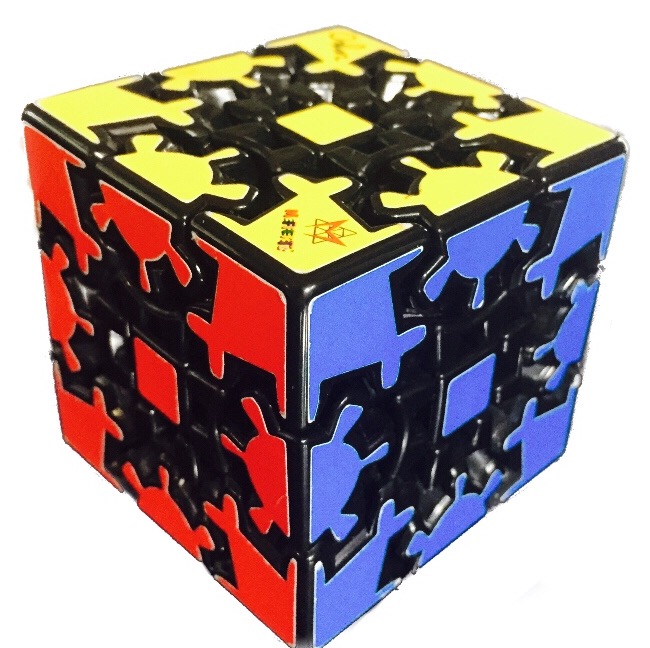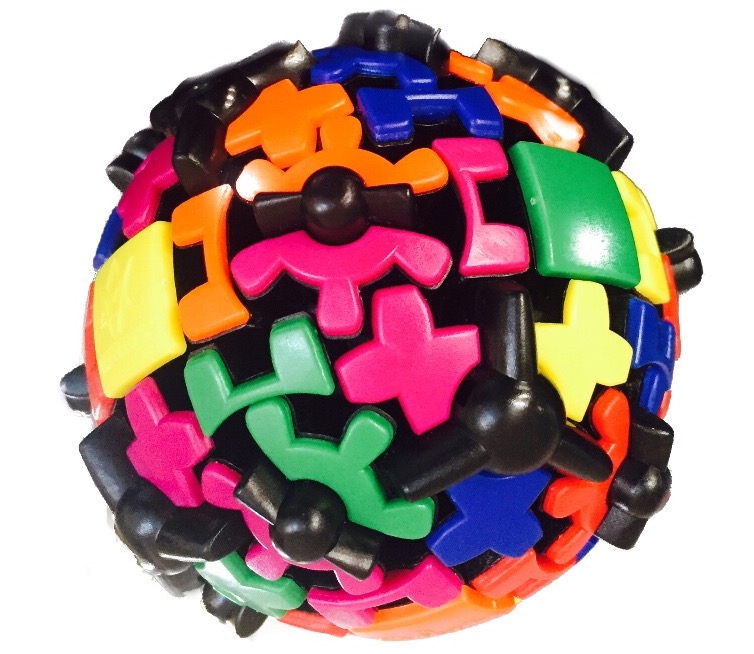|
Oskar Van Deventer
Oskar van Deventer (born 1965) is a Dutch puzzle maker. He prototypes puzzles using 3D printing. His work combines mathematics, physics, and design, and he collaborates at academic institutions. Many of his combination puzzles are in mass production by Uwe Mèffert and WitEden. Oskar van Deventer has also designed puzzles for Hanayama. He was a Guinness World Record holder for his 17×17×17 "Over the Top Cube" Rubik's cube-style puzzle from 2012 to 2016, when it was beaten by a 22×22×22 cube. In addition to being a puzzle maker, Oskar is a research scientist in the area of media networking and holds a Ph.D. in optics. He has over 100 publications, over 80 patents applications, and hundreds of standardization contributions. Mass produced puzzles * Gear cube: Previously named "Caution Cube" because there was a big chance to pinch your fingers with the gears. It was mass-produced by Mèffert's in 2010, but over time it appeared as several copies and shape mods of the same d ... [...More Info...] [...Related Items...] OR: [Wikipedia] [Google] [Baidu] |
Wageningen, Netherlands
Wageningen () is a municipality and a historic city in the central Netherlands, in the province of Gelderland. It is famous for Wageningen University, which specialises in life sciences. The municipality had a population of in , of which many thousands are students from over 150 countries. Demograpics Inhabitants by nationality 71,68% is Dutch, 28,32% has a migration background. Geography Wageningen is situated on the north bank of the Nederrijn (the Dutch portion of the Lower Rhine) part of the Gelderse valley (Dutch: Gelderse Vallei) and the Veluwe, of which the southwest hill is called the ''Wageningse Berg''. Wageningen can be reached by car from highways A12 via the N781, A15 via the N233 and N225, and A50 via the N225, and from the Ede-Wageningen railway station via a 20-minute bus drive to the Wageningen central terminal (see below)., ''Topographic map of the municipality of Wageningen, July 2013 (click to enlarge)'' History The oldest known settlements in the W ... [...More Info...] [...Related Items...] OR: [Wikipedia] [Google] [Baidu] |
Rubik's Cube
The Rubik's Cube is a Three-dimensional space, 3-D combination puzzle originally invented in 1974 by Hungarians, Hungarian sculptor and professor of architecture Ernő Rubik. Originally called the Magic Cube, the puzzle was licensed by Rubik to be sold by Pentangle Puzzles in the UK in 1978, and then by Ideal Toy Company, Ideal Toy Corp in 1980 via businessman Tibor Laczi and Seven Towns founder Tom Kremer. The cube was released internationally in 1980 and became one of the most recognized icons in popular culture. It won the 1980 Spiel des Jahres, German Game of the Year special award for Best Puzzle. , 350 million cubes had been sold worldwide, making it the world's bestselling puzzle game and bestselling toy. The Rubik's Cube was inducted into the US National Toy Hall of Fame in 2014. On the original classic Rubik's Cube, each of the six faces was covered by nine stickers, each of one of six solid colours: white, red, blue, orange, green, and yellow. Some later versions ... [...More Info...] [...Related Items...] OR: [Wikipedia] [Google] [Baidu] |
Puzzle Designers
A puzzle is a game, problem, or toy that tests a person's ingenuity or knowledge. In a puzzle, the solver is expected to put pieces together ( or take them apart) in a logical way, in order to arrive at the correct or fun solution of the puzzle. There are different genres of puzzles, such as crossword puzzles, word-search puzzles, number puzzles, relational puzzles, and logic puzzles. The academic study of puzzles is called enigmatology. Puzzles are often created to be a form of entertainment but they can also arise from serious mathematical or logical problems. In such cases, their solution may be a significant contribution to mathematical research. Etymology The ''Oxford English Dictionary'' dates the word ''puzzle'' (as a verb) to the end of the 16th century. Its earliest use documented in the ''OED'' was in a book titled ''The Voyage of Robert Dudley...to the West Indies, 1594–95, narrated by Capt. Wyatt, by himself, and by Abram Kendall, master'' (published circa 1595) ... [...More Info...] [...Related Items...] OR: [Wikipedia] [Google] [Baidu] |
Living People
Related categories * :Year of birth missing (living people) / :Year of birth unknown * :Date of birth missing (living people) / :Date of birth unknown * :Place of birth missing (living people) / :Place of birth unknown * :Year of death missing / :Year of death unknown * :Date of death missing / :Date of death unknown * :Place of death missing / :Place of death unknown * :Missing middle or first names See also * :Dead people * :Template:L, which generates this category or death years, and birth year and sort keys. : {{DEFAULTSORT:Living people 21st-century people People by status ... [...More Info...] [...Related Items...] OR: [Wikipedia] [Google] [Baidu] |
Bram Cohen
Bram Cohen is an American computer programmer, best known as the author of the peer-to-peer (P2P) BitTorrent protocol in 2001, as well as the first file sharing program to use the protocol, also known as BitTorrent. He is also the co-founder of CodeCon and organizer of the San Francisco Bay Area P2P-hackers meeting, was the co-author of Codeville and creator of the Chia cryptocurrency which implements the proof of space-time consensus algorithm. Early life and career Cohen grew up in the Upper West Side of Manhattan, New York City, as the son of a teacher and computer scientist. He claims he learned the BASIC programming language at the age of 5 on his family's Timex Sinclair computer. Cohen passed the American Invitational Mathematics Examination to qualify for the United States of America Mathematical Olympiad while he attended Stuyvesant High School in New York City. He is also an alumnus of the Hampshire College Summer Studies in Mathematics program. He graduated from Stu ... [...More Info...] [...Related Items...] OR: [Wikipedia] [Google] [Baidu] |
YouTube
YouTube is a global online video sharing and social media platform headquartered in San Bruno, California. It was launched on February 14, 2005, by Steve Chen, Chad Hurley, and Jawed Karim. It is owned by Google, and is the second most visited website, after Google Search. YouTube has more than 2.5 billion monthly users who collectively watch more than one billion hours of videos each day. , videos were being uploaded at a rate of more than 500 hours of content per minute. In October 2006, YouTube was bought by Google for $1.65 billion. Google's ownership of YouTube expanded the site's business model, expanding from generating revenue from advertisements alone, to offering paid content such as movies and exclusive content produced by YouTube. It also offers YouTube Premium, a paid subscription option for watching content without ads. YouTube also approved creators to participate in Google's AdSense program, which seeks to generate more revenue for both parties ... [...More Info...] [...Related Items...] OR: [Wikipedia] [Google] [Baidu] |
Gear Cube
The Gear Cube is a 3-D combination puzzle designed and created by Dutch puzzle maker Oskar van Deventer based on an idea by Bram Cohen. It was initially produced by Shapeways in 2009 and known as "Caution Cube" due to the likelihood of getting one's fingers stuck between the gears while speedcubing. Later, in 2010, it was mass-produced by Meffert's as the "Gear Cube". Compared to the original Rubik's Cube, this cube uses a complete gear mechanism. It requires six 180° turns to complete one rotation, resulting in a twisty puzzle. The design of the Gear Cube places all gears externally in order for the mechanics to be seen. While looking rather formidable at first sight, it is nevertheless simpler to solve than the original Rubik's Cube. There are two objectives when solving the cube. The first goal is taking the mixed-up puzzle back to its original cubic state. The second goal is to actually solve the puzzle by arranging each side back to its own beginning color. Mechanics Th ... [...More Info...] [...Related Items...] OR: [Wikipedia] [Google] [Baidu] |
Hanayama
Hanayama is a Japanese toy company founded in 1933. They are best known for their metal disassembly puzzles " HUZZLE" series (also known as "CAST PUZZLE"), which include reproductions of older designs, and new puzzles by other inventors such as Oskar van Deventer and Akio Yamamoto. References External linksOfficial Website (Japanese) Toy companies of Japan 1972 establishments in Japan Design companies established in 1972 [...More Info...] [...Related Items...] OR: [Wikipedia] [Google] [Baidu] |
Netherlands Organisation For Applied Scientific Research
Nederlandse Organisatie voor Toegepast Natuurwetenschappelijk Onderzoek (TNO; en, Netherlands Organisation for Applied Scientific Research) is an independent research organisation in the Netherlands that focuses on applied science. The organisation also conducts contract research, offers specialist consulting services, and grants licences for patents and specialist software. TNO tests and certifies products and services, and issues an independent evaluation of quality. Moreover, TNO sets up new companies to market innovations. Background TNO was established by law in 1932 to support companies and governments with innovative, practicable knowledge. As a statutory organisation, TNO has an independent position that allows to give objective, scientifically founded judgments. It is similar to the following: * CSIR in Ghana * CSIR in India * CSIR in South Africa * CSIRO in Australia * Fraunhofer Society in Germany * SINTEF in Norway Furthermore, TNO also held 10% of the Austrian ... [...More Info...] [...Related Items...] OR: [Wikipedia] [Google] [Baidu] |
Uwe Mèffert
Uwe Mèffert (28 November 1939–30 April 2022) was a German puzzle designer and inventor. He manufactured and sold mechanical puzzles in the style of Rubik's Cube since the Cube craze of the 1980s. His first design was the Pyraminx – which he had developed before the original Rubik's Cube was invented. He created his own puzzle company and helped bring to market the Megaminx, Skewb, Skewb Diamond and many other puzzles. Puzzle history Invention of the Pyraminx In the early 1970s, Mèffert was interested in whether pyramids, cubes and other shapes might influence one's health and bio-energy flows. Mèffert constructed balsa wood polyhedra and found the gentle stroking of the apexes of the various shapes had a gentle massaging and stimulating influence and instilled a sense of peace, relaxation, and calm. After playing around with this idea for a while, he cut the solids into symmetric slices and attached them with rubber bands to a center ball. With the aid of his brother (an ... [...More Info...] [...Related Items...] OR: [Wikipedia] [Google] [Baidu] |




